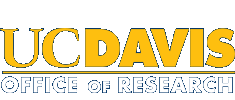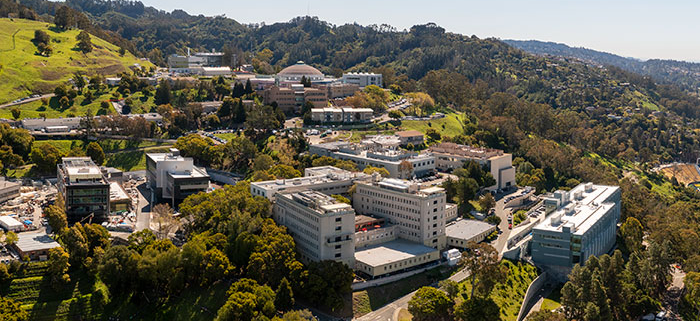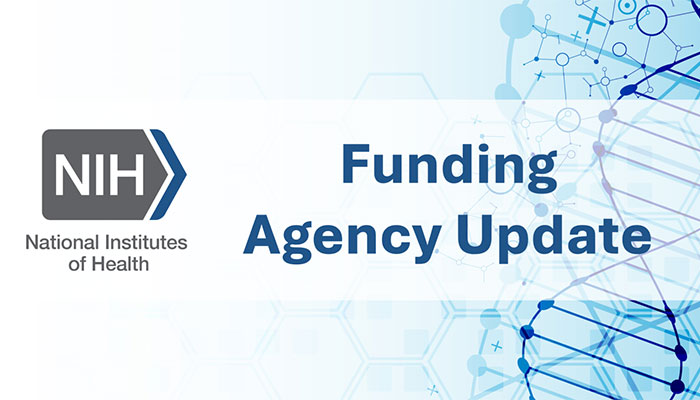UC Davis and Lawrence Berkeley National Laboratory Scientists Collaborate on Agricultural Decarbonization
In collaboration with Lawrence Berkeley National Laboratory (Berkeley Lab), the University of California, Davis, Office of Research has named four UCD-Berkeley Lab Faculty Fellows for 2024: Amélie Gaudin from the Department of Plant Sciences, Jorge Mazza Rodrigues from the Department of Land, Air and Water Resources, Laura Bogar from the Department of Plant Biology, and Md Shamim Ahamed from the Department of Biological and Agricultural Engineering. These Faculty Fellows have formed three teams that are receiving $25,000 each to initiate cross-campus research projects with Berkeley Lab scientists in the field of agricultural decarbonization.
In the United States, agricultural practices contribute to over 10% of the country’s total greenhouse gas emissions. To reduce the environmental impact of modern agricultural systems, UC Davis and Berkeley Lab researchers are investigating new practices that, if incorporated, could remove additional carbon dioxide from the atmosphere and minimize the energy footprint needed for crop production. This movement of carbon into inaccessible areas is known as carbon sequestration. Both reducing energy waste and sequestering carbon are expected to aid the decarbonization efforts in the agricultural industry, and the awarded Faculty Fellows have developed new and innovative ways to address the climate crisis.
Can plants pick downstairs neighbors?
Though we tend to view plants at the surface level, there is a vast world teeming with microscopic life in the soil below, arranged in communities called microbiomes. These microbiomes can associate with the roots of plants, and the beneficial microbes within can improve the growth and health of their host. Understanding plant-microbe interactions has implications for improving atmospheric carbon removal and sequestration, which is why Jorge Mazza Rodrigues and Amélie Gaudin are collaborating with Kateryna Zhalnina, a research scientist from Berkeley Lab’s Environmental Genomics and Systems Biology Division, to study these interactions in cover crop plants and how they might facilitate decarbonization.
Taking it from the top, farmers can plant cover crops under tree crops or in between rounds of primary cash crops, which helps regenerate and protect fields after the nutritional drain of a main harvest. After flowering, cover crops are commonly cut down or left alone in fields, allowing for the plants to decompose and provide multiple soil health benefits. As it grows and breaks down into the ground, these plants release their contents, fueling microorganisms in soil communities and shaping what they do. The impact of the cover cropping process on microbes remains largely unclear, but the team hopes to leverage the choice of cover crops to improve carbon sequestration in agricultural use.
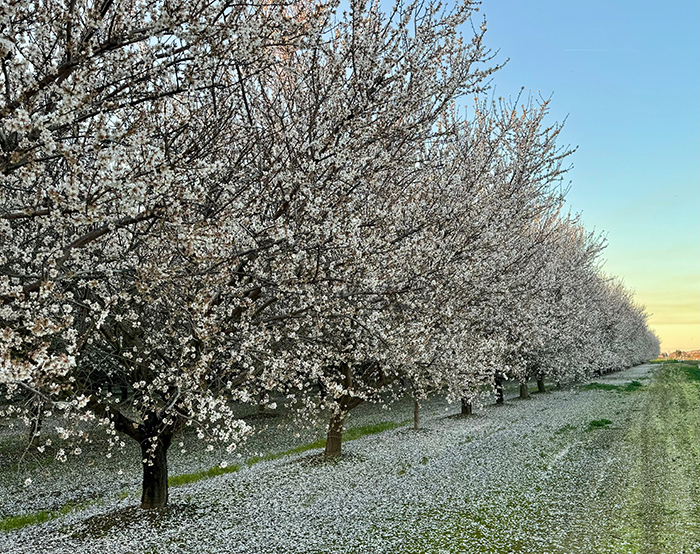
An almond orchard, an example of tree crops that can benefit from cover cropping systems. Photo Credit: Jorge Mazza Rodrigues/UC Davis
Zhalnina is an expert in studying the chemical signals that plants make and how they interact with microbes, and she shared her research breakthrough with us: “We were able to find some molecules that plants produce that are able to attract beneficial microbes, but the work we’ve done in the lab so far has used only a single plant species.” Though she has identified a chemical signal that draws beneficial microbes to plant roots to help them grow, this was done in the strictly controlled environment of labs and greenhouses, which are vastly different from the conditions in an outdoor field. Furthermore, testing a single species of plant in an experiment is different from how things work in nature, and as Zhalnina said, “Greater aboveground plant diversity is expected to result in larger belowground chemical and microbial diversity, enhancing the efficiency of carbon sequestration in ecosystems.”
To tackle the plant and microbial diversity aspect, Gaudin and Rodrigues have brought their expertise to initiate their UC Davis-Berkeley Lab collaboration. Rodrigues said, “We have different scales in our group that we bring together: [Gaudin] supports farmers with large-scale fields, I’m more interested at the soil scale, and we have [Zhalnina] who works at the molecular scale, giving us a continuum of understanding.” Gaudin specializes in studying the effect of different cover crops mixes, and Rodrigues in identifying and profiling the behavior of soil microbiomes. Combining the findings and goals of Gaudin’s, Rodrigues,’ and Zhalnina’s research could increase the impact of cover cropping on soil health and carbon removal from the atmosphere, and as Gaudin said, “It’s about benefits, tradeoffs, and synergy.” For example, a cover crop blend selected by Gaudin could release certain chemical signals into the soil that Zhalnina can identify, and Rodrigues will be able to track the response of microbiomes that will thrive in that environment and see how they might help plants uptake even more carbon. “We want to understand these systems so we can pick the right plant species for specific microbial mechanisms to enhance cover crop carbon sequestration and provide benefits for farmers and the environment,” elaborated Gaudin.
With the knowledge of Gaudin’s cover crop blends, Zhalnina can also leverage the technological advantage at Berkeley Lab to improve future lab studies on these plant-microbe interactions. Berkeley Lab’s Environmental Genomics and Systems Biology Division has pioneered EcoPOD technology – enclosed environments that facilitate the experimental monitoring and manipulation of interactions between plants, soil, microbes, and the atmosphere. “This is a unique capability connecting the science we do in the field and in the lab,” Zhalnina said, “and we can definitely use it for this project as well.” With the ability to carefully control the internal environment, the EcoPODs can be used to mimic drought and extreme heat conditions, as a way of testing how cover crop blends and their soil microbiomes react to climates they may experience in the field.
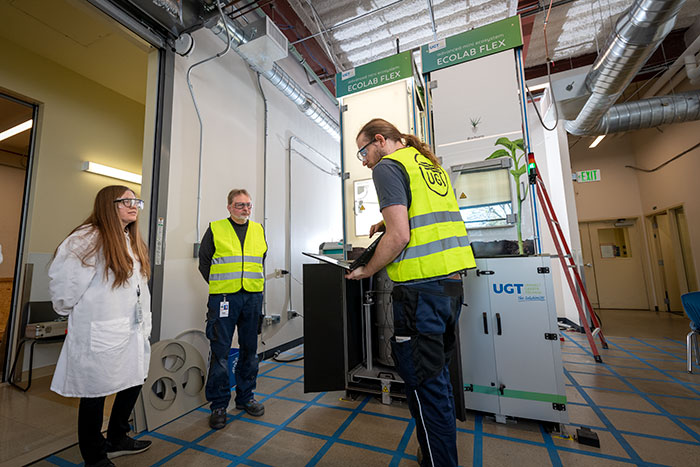
Kateryna Zhalnina oversees the installation of EcoPOD instruments at Berkeley Lab. Photo Credit: Thor Swift/Berkeley Lab
Outside of the lab, Gaudin has fostered close relationships with Californian farmers and growers. “I often get the question ‘What should I plant?’”, she said. Though farmers are rarely looking to select cover crops for improved carbon sequestration alone, Gaudin hopes that the improved understanding of plant-soil-microbe interactions from this project will offer some incentive to plant mixes of species that are good for productivity and help remove additional carbon from the atmosphere, providing a win-win for people and the environment. As summarized by Rodrigues, “We want farmers to feel confident that they can put these plants in the soil and support our goals of carbon sequestration while improving their own fields.”
Seeing the forest for the fungi
In addition to crop fields, forests are another major player in agricultural carbon dioxide removal. Laura Bogar and Berkeley Lab scientist Eoin Brodie from the Earth and Environmental Sciences Area have been awarded funds to initiate their collaboration and work towards understanding the movement of carbon from trees to the soil. Bogar will combine her extensive experience in studying fungi with Brodie’s expertise in simulating ecosystems to improve the accuracy of predicting tree-fungi interactions and their effect on decarbonization.
Fungi can associate with the roots of many plants, including trees, in a relationship called a mycorrhiza. In mycorrhizae, fungi trade nutrients and minerals for sugars from trees, helping both grow. Not only is this exchange beneficial for the health of trees and fungi alike, but it also moves more carbon out of the atmosphere and into the ground, which has great importance as a strategy to fight climate change. By studying the fungi in mycorrhizae, Bogar hopes to use this information to enhance carbon removal and storage when caring for our forests. “If we can find the right combination of fungal species and traits associated with long-term carbon sequestration, we might be able to more effectively manage our forests and help us balance our carbon budget.”
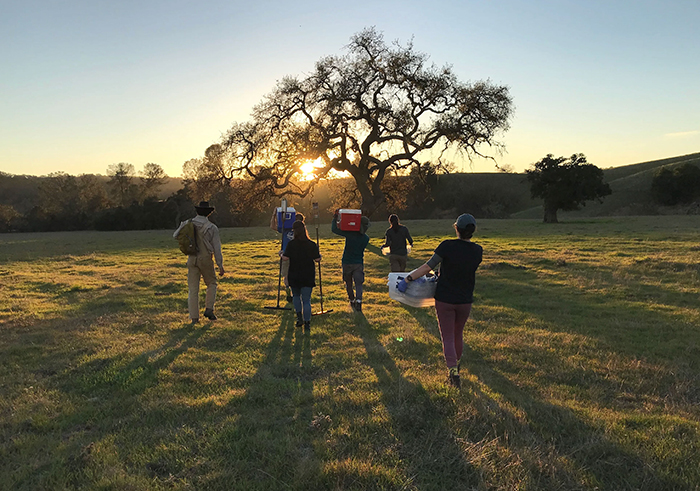
Laura Bogar’s team prepares to collect soil samples for analysis. Photo Credit: Laura Bogar/UC Davis
Though Bogar’s research starts with California forests, the climate problem affects environments of all types and locations. In response to this challenge, the U.S. Department of Energy’s Office of Science has tasked the Biological and Environmental Research program to improve our understanding of how ecosystems and their members interact with the environment. As part of Berkeley Lab’s contributions to the broader DOE mission, Brodie utilizes a unique system called EcoSIM to predict and study plant-soil-microbe interactions and their effects on the environment. As shared by Brodie, “Our goal with EcoSIM was to develop a computer model to represent these interactions under current and future conditions at ecosystem scale.” While most existing models simplify certain aspects of ecosystems, the computing power available at Berkeley Lab for EcoSIM will allow for mycorrhizal interactions to be accounted for when predicting environmental responses to climate change. As an example of what the enhanced EcoSIM models could do, Bogar shared, “If we know we have this particular mix of trees, we can identify what traits are in their fungal communities and make useful management decisions for carbon sequestration.”
The combination of Bogar and Brodie’s research will allow them to paint a much more accurate picture of how mycorrhizae affect and respond to a changing climate. “I’m really excited about incorporating microbial traits into models of plant-soil interactions and carbon fixation on really large landscape scales,” said Bogar, “Since we can carefully measure fungal traits in relevant settings that contribute to forestry management practices and feed them into [Brodie’s] models to improve predictive power.” As summed up by Brodie, “Working together with Laura to find a practical way to represent the properties of fungi in these models is really key, and it’s great that we have the expertise to collaborate with at UC Davis.”
Greenhouses going greener
As a result of changing climates worldwide, agricultural land is rapidly being lost. To counteract this, growers are turning to controlled environment agriculture facilities, such as greenhouses, to recreate the conditions for crop production. However, greenhouses are an energy-intensive investment, and most of the electricity used for temperature control and lighting originates from fossil fuels. To help reduce their environmental impact, Md Shamim Ahamed and Yi Liu from the Berkeley Lab’s Molecular Foundry are testing new and innovative ways to incorporate solar panels into the greenhouse setting and make the most out of our natural resources.
While we know that plants need light, not all of it is being used for growth. Excess light energy can be bad for plants and must be dissipated as heat, resulting in a loss of unusable energy. In greenhouses, this is worsened by the fact that the glass walls can trap some of this heat, resulting in an increased need for cooling and dehumidification inside. Consequentially, greenhouses must compensate for these higher temperatures and use extra water for plants and cooling, resulting in a hefty dependence on valuable resources that can take a toll on the environment.
However, one plant’s waste is Ahamed’s treasure, as his research has led him to investigate new ways of putting the original excess light energy to work. Ahamed specializes in simulating greenhouse microclimates with photo-selective solar cells, which are designed to capture specific wavelengths of light and let others pass. Ahamed explained, “If sunlight comes and not all of it is required, we can tune the solar cell to harvest energy from the excess light not used by the plant, and the plant can get the light it needs.” This approach also has incredible promise for energy savings and returns: “If you don’t pass all the light to crops, you can reduce the necessary cooling for greenhouses and convert it to power.” By skimming excess light off the top of the greenhouse environment, a photo-selective solar setup can deliver quite a few benefits: plants will get enough light to grow, solar energy will be generated from otherwise wasted light, and cooling and water bills will drop. Beyond producing crops, these types of setups can also increase the self-sufficiency of greenhouses, where the on-site solar power could be used to help meet the demand of functions like lighting, cooling, ventilation, etc.
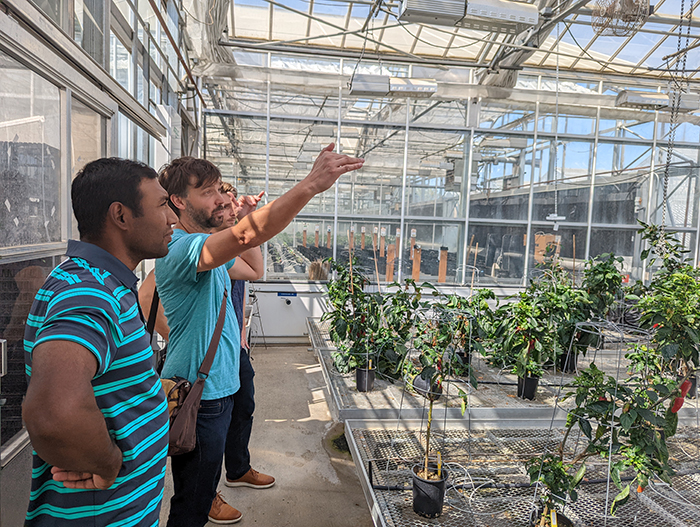
Md Shamim Ahamed tours a conventional greenhouse. Photo Credit: Unknown
On the other end of the spectrum, Liu harnesses the capabilities of the Molecular Foundry at Berkeley Lab to make the photo-selective solar cells outlined in Ahamed’s research. “We are interested in using flexible, lightweight, and easy-to-make solar cells with comparable efficiency to existing panels,” said Liu. Though solar energy is climate-friendly, the production and shipping of the technology still comes at an environmental cost. To help reduce that burden, Liu can make and test solar cells that will be easy to produce and ship, minimizing the footprint of what comes before their use. Efficiency is the name of the game for Liu, and he hopes that these efforts will catch the eye of bigger industries. He shared, “We would like to incentivize the energy industry and lead to a more resilient economy while reducing greenhouse gas emissions – a win-win climate-smart solution.”
The combination of Ahamed’s and Liu’s efforts can drastically accelerate the research process for incorporating new solar technologies into controlled environment agricultural facilities. “On the UC Davis side, Shamim is an expert in modeling and simulations,” said Liu, “and we at Berkeley Lab will design and support the development of solar cells suitable for greenhouses.” Both investigators are keen to see the deployment of their research, not only for the benefit of users and the economy, but also for the effect it will have on combatting the climate crisis. “Current studies show that the carbon footprint of controlled environment agriculture is not attractive because of the energy demands,” said Ahamed, “But if this research can be implemented, we can reduce the energy cost, reduce water usage, and produce green energy on-site. We can reduce carbon emissions from food production, and there’s the target – net zero greenhouse production.”
Funding for the future
Beyond working towards the broader goal of agricultural decarbonization, all three teams will help train the next generation of scientists under the Faculty Fellows award program. Jorge Mazza Rodrigues’ and Amélie Gaudin’s teams will be training a mix of graduate and undergraduate students to conduct their microbiome and soil studies, while Kateryna Zhalnina’s group at Berkeley Lab will have postdoctoral scholars hone their research expertise in identifying the effects of chemical signals on microbes. As part of their collaboration with Eoin Brodie’s research group, Laura Bogar’s graduate students will gain access to the field sites at the Blodgett Forest Research Station in the Sierra Nevada mountains, allowing them to gain on-site experience working with the native conditions of the mycorrhizal fungi in our forests. As a user facility, the Molecular Foundry and Yi Liu’s group will welcome researchers from Md Shamim Ahamed’s team to make and test their own solar cells at the Lab. The efforts from both UC Davis and Berkeley Lab to help scientists acquire new skills and gain experience in their fields will ensure that the technologies that arise from these partnerships will have a skilled workforce to maintain and use them, something that will be necessary for continued resilience against the climate crisis.
The second round of Interdisciplinary Research Catalyst: Faculty Fellows Program – UCD/Berkeley Lab Partnership awards was announced following the Ag Decarbonization workshop at Berkeley Lab on September 14th, 2023. Since 2020, the UC Davis Office of Research and the Berkeley Lab’s Office of the Deputy Director for Research have worked to reinvigorate the longstanding partnership between our institutions, with mutual interest in supporting graduate student and researcher mobility and diversity, equity, and inclusion in STEM. Bill Johansen, Senior Advisor to the Deputy Laboratory Director for Research at LBNL, shared the following: “Berkeley Lab appreciates the history of collaboration and engagements between our researchers and the UC Davis faculty. This second round of Faculty Fellows from the Office of Research offers a great opportunity for Berkeley Lab and Davis to find new innovative projects to explore research areas where bringing the strength of our two institutions together will provide new ideas for critical research questions.”
Media Contact
Albert Liu, UC Davis Office of Research, [email protected]
Neelanjana Gautam, UC Davis Office of Research, [email protected]
